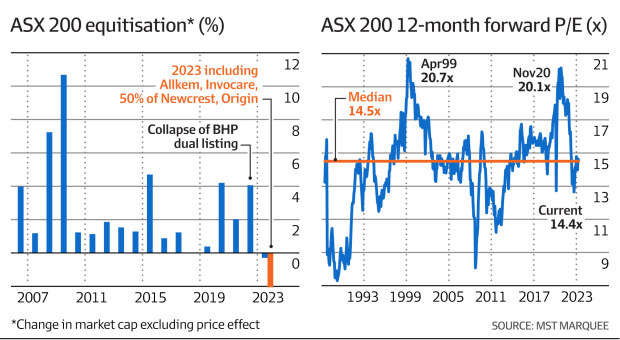Chanticleer

Two banking legends on what the IPO drought says about capital markets
Goldman Sachs’ Christian Johnston and Citi’s Tony Osmond are united in their views on the forces driving the Incredible Shrinking ASX.
As two of the elder statesmen of Australia’s investment banking sector, Goldman Sachs’ Christian Johnston and Citi’s Tony Osmond have faced each other across the deal table on countless occasions.
But the pair are united in their views on the forces driving what Chanticleer likes to call the incredible shrinking ASX.
According to figures from MST Marquee senior analyst Hasan Tevfik, the ASX is set to shrink by $43 billion, or about 2 per cent, by the end of the calendar year thanks to a combination of major takeovers (including Newcrest, Origin Energy and Oz Minerals), a rush of share buybacks (there are about 25 underway at present) and dearth of floats (the ASX has only seen one float worth more than $100 million since the start of 2022).

For Johnston and Osmond, it’s the latter trend that stands out.
“We’re not filling up the bucket with enough IPOs,” Osmond says. “Some of that is cyclical, but some of that is also structural.”
One of the big factors keeping companies private is the rise and rise of private capital.
“It used to be you had to list to get access to capital, and you now don’t need to,” Johnston says.
Osmond further argues that the regulatory hurdles for public companies to overcome is a further burden.
“We’ve made listing so hard that a lot of companies don’t take that path any more.”
The structure of the market is different, too. Where once local active fund managers would decide the fate of a new float, the rise and rise of passive investing means support needs to come from elsewhere.
“That pool of active fund managers has shrunk so much that it’s almost impossible now to get an IPO up unless you’ve gone separately to the big super funds and tried to get someone to anchor the deal,” Osmond says, adding the tilt towards passive investing “impacts everything – how you do an IPO, how you raise capital, how you do M&A.”
Johnston says the changing shape of the stockbroking sector, and the rise of private wealth businesses, has also had an impact on how a float is pitched.
“The private wealth firms have always had to be a price taker – they’ve been comfortable that the price of the IPO has been set by these sophisticated institutional investors later [in the IPO process].
Limiting investor choice
“Now those private wealth organisations are a little bit more discerning and not necessarily wanting to take that market risk and pricing risk. That is a bit more nuanced than it used to be.”
Osmond worries that the shrinking of the ASX is limiting choice to local investors. The best example this column sees is exposure to copper, the vital commodity of the energy transition; with BHP’s takeover of OZ Minerals earlier this year, Australians no longer have a top quality, pure-play copper miner to play this thematic.
Johnston appreciates the choice issue, but is more sanguine about the changes in the market.
“If you look at the number of listed companies in Australia for our market cap we are still very high relative to other markets,” he says.
“I am not worried yet. But I do think that trend is going to continue.”
Both bankers, who are also on the panel of non-for-profit corporate advisory Adara Group, say the best way to encourage more companies to list on the ASX is for a float to get away successfully. The prospective IPOs of Virgin Australia and chemicals group Redox in the second half of that year could well provide that moment.
Outside of IPOs, Osmond and Johnston say boardroom confidence remains solid enough, and there is plenty of activity in M&A, albeit below the extraordinary peaks seen during the pandemic years.
“I’m working on just as many things, but they are at an early stage, they’re smaller and probably a bit more complex,” Osmond says.
Osmond argues some long-standing areas of uncertainty in the economy are clearing up, with inflation now past the peak and interest rates close to their peak.
But the pair say there are still pockets of pain to watch.
“One of the concerns I have is, have we seen the impact of those higher rates? And what does that do to earnings and therefore confidence?” Johnston says.
Osmond agrees. “If you’re consumer-facing at the moment, that’s pretty scary.”
Subscribe to gift this article
Gift 5 articles to anyone you choose each month when you subscribe.
Subscribe nowAlready a subscriber?
Introducing your Newsfeed
Follow the topics, people and companies that matter to you.
Find out moreRead More
Latest In Equity markets
Fetching latest articles